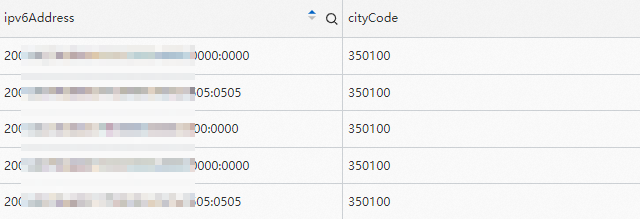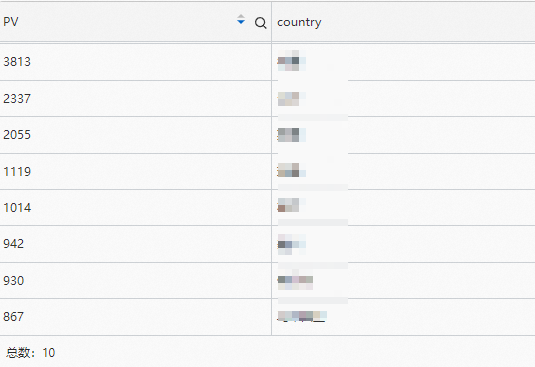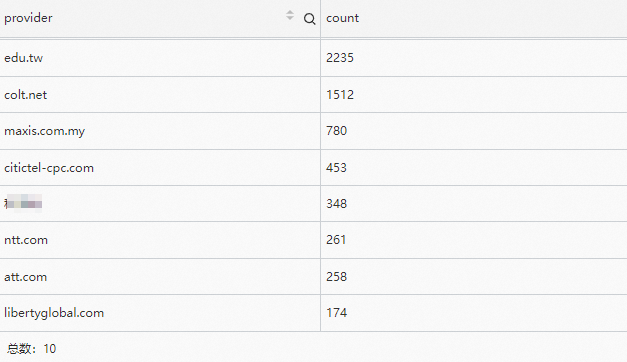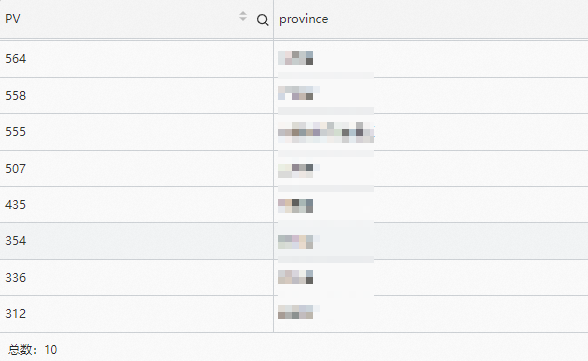This topic describes the syntax of IP functions. This topic also provides examples on how to use the functions.
The following table describes the IP functions that are supported by Simple Log Service.
If you want to use strings in analytic statements, you must enclose the strings in single quotation marks (''). Strings that are not enclosed or strings that are enclosed in double quotation marks ("") indicate field names or column names. For example, 'status' indicates the status string, and status or "status" indicates the status log field.
Category | Function | Syntax | Description | Supported in SQL | Supported in SPL |
IPv4 address functions | ip_to_city(x) | Identifies the city to which an IPv4 address belongs. The function returns the Chinese name of a city. | √ | × | |
ip_to_city(x, 'en') | Identifies the city to which an IPv4 address belongs. The function returns the administrative division code of a city. | √ | × | ||
ip_to_city_geo(x) | Identifies the longitude and latitude of the city to which an IPv4 address belongs. The function returns the longitude and latitude of a city. Each city has only one set of coordinates. | √ | × | ||
ip_to_country(x) | Identifies the country or region to which an IPv4 address belongs. The function returns the Chinese name of a country or region. | √ | × | ||
ip_to_country(x, 'en') | Identifies the country or region to which an IPv4 address belongs. The function returns the code of a country or region. | √ | × | ||
ip_to_country_code(x) | Identifies the country or region to which an IPv4 address belongs. The function returns the code of a country or region. | √ | × | ||
ip_to_domain(x) | Checks whether an IPv4 address is a private or public address. | √ | × | ||
ip_to_geo(x) | Identifies the longitude and latitude of the location of an IPv4 address. | √ | × | ||
ip_to_provider(x) | Identifies the Internet service provider (ISP) of an IPv4 address. | √ | × | ||
ip_to_province(x) | Identifies the state to which an IPv4 address belongs. The function returns the Chinese name of a state. | √ | × | ||
ip_to_province(x, 'en') | Identifies the state to which an IPv4 address belongs. The function returns the administrative division code of a state. | √ | × | ||
IPv4 CIDR block functions | ip_prefix(x, prefix_bits) | Returns the prefix of an IPv4 address. | √ | × | |
is_prefix_subnet_of(x, y) | Checks whether an IPv4 CIDR block is a subnet of a specified CIDR block. | √ | × | ||
is_subnet_of(x, y) | Checks whether an IPv4 address is in a specified CIDR block. | √ | × | ||
ip_subnet_max(x) | Returns the largest IP address in an IPv4 CIDR block. | √ | × | ||
ip_subnet_min(x) | Returns the smallest IP address in an IPv4 CIDR block. | √ | × | ||
ip_subnet_range(x) | Returns the range of an IPv4 CIDR block. | √ | × | ||
IPv6 address functions | ipv6_to_city(x) | Identifies the city to which an IPv6 address belongs. | √ | × | |
ipv6_to_city_code(x) | Identifies the administrative division code of the city to which an IPv6 address belongs. | √ | × | ||
ipv6_to_city_geo(x) | Identifies the longitude and latitude of the city to which an IPv6 address belongs. | √ | × | ||
ipv6_to_country(x) | Identifies the country or region to which an IPv6 address belongs. | √ | × | ||
ipv6_to_country_code(x) | Identifies the code of the country or region to which an IPv6 address belongs. | √ | × | ||
ipv6_to_domain(x) | Checks whether an IPv6 address is a private or public address. | √ | × | ||
ipv6_to_provider(x) | Identifies the ISP of an IPv6 address. | √ | × | ||
ipv6_to_province(x) | Identifies the province to which an IPv6 address belongs. | √ | × | ||
ipv6_to_province_code(x) | Identifies the administrative division code of the province to which an IPv6 address belongs. | √ | × |
ip_to_city function
The ip_to_city function identifies the city to which an IPv4 address belongs.
Syntax
If you use the following syntax, the function returns the Chinese name of a city.
ip_to_city(x)If you use the following syntax, the function returns the administrative division code of a city.
ip_to_city(x,'en')
Parameters
Parameter | Description |
x | The value of this parameter is an IPv4 address. |
Return value type
The varchar type.
Examples
Calculate the average processing time of requests and maximum processing time of requests by city, and obtain the IDs of requests that require the maximum processing time.
Query statement
* | SELECT AVG(request_time) AS avg_request_time, MAX(request_time) AS max_request_time, MAX_BY(requestId, request_time) AS requestId, ip_to_city(client_ip) AS city GROUP BY cityQuery and analysis results

ip_to_city_geo function
The ip_to_city_geo function identifies the longitude and latitude of the city to which an IPv4 address belongs. The function returns the longitude and latitude of a city. Each city has only one set of coordinates.
Syntax
ip_to_city_geo(x)Parameters
Parameter | Description |
x | The value of this parameter is an IPv4 address. |
Return value type
The varchar type. Format: latitude,longitude.
Examples
Obtain the longitude and latitude for an IPv4 address and the distribution of clients.
Query statement
* | SELECT count(*) AS PV, ip_to_city_geo(client_ip) AS geo GROUP BY geo ORDER BY PV DESCQuery and analysis results

ip_to_country function
The ip_to_country function identifies the country or region to which an IPv4 address belongs.
Syntax
If you use the following syntax, the function returns the Chinese name of a country or region.
ip_to_country(x)If you use the following syntax, the function returns the code of a country or region.
ip_to_country(x,'en')
Parameters
Parameter | Description |
x | The value of this parameter is an IPv4 address. |
Return value type
The varchar type.
Examples
Calculate the average processing time of requests and maximum processing time of requests by country or region, and obtain the IDs of requests that require the maximum processing time.
Query statement
* | SELECT AVG(request_time) AS avg_request_time, MAX(request_time) AS max_request_time, MAX_BY(requestId, request_time) AS requestId, ip_to_country(client_ip) AS country GROUP BY countryQuery and analysis results

ip_to_country_code function
The ip_to_country_code function identifies the country or region to which an IPv4 address belongs. The function returns the code of a country or region.
Syntax
ip_to_country_code(x)Parameters
Parameter | Description |
x | The value of this parameter is an IPv4 address. |
Return value type
The varchar type.
Examples
Calculate the average processing time of requests and maximum processing time of requests by country or region, and obtain the IDs of requests that require the maximum processing time.
Query statement
* | SELECT AVG(request_time) AS avg_request_time, MAX(request_time) AS max_request_time, MAX_BY(requestId, request_time) AS requestId, ip_to_country_code(client_ip) AS country GROUP BY countryQuery and analysis results

ip_to_domain function
The ip_to_domain function checks whether an IPv4 address is a private or public address.
Syntax
ip_to_domain(x)Parameters
Parameter | Description |
x | The value of this parameter is an IPv4 address. |
Return value type
The varchar type. The function can return only intranet or internet.
intranet: a private address.
internet: a public address.
Examples
Calculate the total number of requests that are not sent from an internal network.
Query statement
* | SELECT count(*) AS PV where ip_to_domain(client_ip) != 'intranet'Query and analysis results

ip_to_geo function
The ip_to_geo function identifies the longitude and latitude of the location of an IPv4 address. For more information about the geohash function, see Geo functions.
Syntax
ip_to_geo(x)Parameters
Parameter | Description |
x | The value of this parameter is an IPv4 address. |
Return value type
The varchar type. Format: latitude,longitude.
Examples
Obtain the longitude and latitude for an IPv4 address and the distribution of clients.
Query statement
* | SELECT count(*) AS PV, ip_to_geo(client_ip) AS geo GROUP BY geo ORDER BY PV DESCQuery and analysis results

ip_to_provider function
The ip_to_provider function identifies the ISP of an IPv4 address.
Syntax
ip_to_provider(x)Parameters
Parameter | Description |
x | The value of this parameter is an IPv4 address. |
Return value type
The varchar type.
Examples
Calculate the average processing time of requests by ISP.
Query statement
* | SELECT avg(request_time) AS avg_request_time, ip_to_provider(client_ip) AS provider GROUP BY provider ORDER BY avg_request_timeQuery and analysis results

ip_to_province function
The ip_to_province identifies the state to which an IP address belongs.
Syntax
If you use the following syntax, the function returns the Chinese name of a state.
ip_to_province(x)If you use the following syntax, the function returns the administrative division code of a state.
ip_to_province(x,'en')
Parameters
Parameter | Description |
x | The value of this parameter is an IPv4 address. |
Return value type
The varchar type.
Examples
Obtain the top 10 states based on the total number of requests.
Query statement
* | SELECT count(*) as PV, ip_to_province(client_ip) AS province GROUP BY province ORDER BY PV desc LIMIT 10If you want to exclude the requests that are sent from an internal network when you obtain the top 10 states, use the following query statement:
* | SELECT count(*) AS PV, ip_to_province(client_ip) AS province WHERE ip_to_domain(client_ip) != 'intranet' GROUP BY province ORDER BY PV DESC LIMIT 10Query and analysis results

ip_prefix function
The ip_prefix function returns the prefix of an IPv4 address. The function returns an IPv4 address in the subnet mask format. Example: 192.168.1.0/24.
Syntax
ip_prefix(x, prefix_bits)Parameters
Parameter | Description |
x | The value of this parameter is an IPv4 address. |
prefix_bits | This parameter specifies the length of the prefix. |
Return value type
The varchar type.
Examples
Obtain the prefix of the IPv4 address in the value of the client_ip field.
Query statement
* | SELECT ip_prefix(client_ip,24) AS client_ipQuery and analysis results

is_prefix_subnet_of function
The is_prefix_subnet_of function checks whether an IPv4 CIDR block is a subnet of a specified CIDR block.
Syntax
is_prefix_subnet_of(x, y)Parameters
Parameter | Description |
x | The value of this parameter is an IPv4 CIDR block. The function checks whether the y CIDR block is a subnet of the x CIDR block. |
y | The value of this parameter is an IPv4 CIDR block. |
Return value type
The Boolean type.
Examples
Check whether the IPv4 CIDR block in the value of the client_ip field is a subnet of 192.168.0.1/24.
Query statement
* | SELECT is_prefix_subnet_of('192.168.0.1/24',concat(client_ip,'/24'))Query and analysis results

is_subnet_of function
The is_subnet_of function checks whether an IPv4 address is in a specified CIDR block.
Syntax
is_subnet_of(x, y)Parameters
Parameter | Description |
x | The value of this parameter is an IPv4 CIDR block. |
y | The value of this parameter is an IPv4 address. |
Return value type
The Boolean type.
Examples
Check whether the IPv4 address in the value of the client_ip field is in 192.168.0.1/24.
Query statement
* | SELECT is_subnet_of('192.168.0.1/24',client_ip)Query and analysis results

ip_subnet_min function
The ip_subnet_min function returns the smallest IP address in an IPv4 CIDR block.
Syntax
ip_subnet_min(x)Parameters
Parameter | Description |
x | The value of this parameter is an IPv4 CIDR block. |
Return value type
The varchar type.
Examples
Obtain the smallest IP address in the IPv4 CIDR block to which the IP address in the value of the client_ip field belongs.
Query statement
* | SELECT ip_subnet_min(concat(client_ip,'/24'))Query and analysis results

ip_subnet_max function
The ip_subnet_max function returns the largest IP address in an IPv4 CIDR block.
Syntax
ip_subnet_max(x)Parameters
Parameter | Description |
x | The value of this parameter is an IPv4 CIDR block. |
Return value type
The varchar type.
Examples
Obtain the largest IP address in the IPv4 CIDR block to which the IP address in the value of the client_ip field belongs.
Query statement
* | SELECT ip_subnet_max(concat(client_ip,'/24'))Query and analysis results

ip_subnet_range function
The ip_subnet_range function returns the range of an IPv4 CIDR block.
Syntax
ip_subnet_range(x)Parameters
Parameter | Description |
x | The value of this parameter is an IPv4 CIDR block. |
Return value type
The JSON type.
Examples
Obtain the range of the IPv4 CIDR block to which the IP address in the value of the client_ip field belongs.
Query statement
* | SELECT ip_subnet_range(concat(client_ip,'/24'))Query and analysis results

ipv6_to_city function
The ipv6_to_city function identifies the city to which an IPv6 address belongs.
Syntax
ipv6_to_city(x)Parameters
Parameter | Description |
x | The value of this parameter is an IPv6 address. |
Return value type
The varchar type.
Examples
Obtain the numbers of requests that are sent from different cities.
Query statement
* | SELECT ipv6_to_city(ipv6Address) AS city, count(*) AS count GROUP BY cityQuery and analysis results

ipv6_to_city_code function
The ipv6_to_city_code function identifies the administrative division code of the city to which an IPv6 address belongs.
Syntax
ipv6_to_city_code(x)Parameters
Parameter | Description |
x | The value of this parameter is an IPv6 address. |
Return value type
The varchar type.
Examples
Obtain the administrative division code of the city to which an IPv6 address belongs.
Query statement
* | SELECT ipv6Address, ipv6_to_city_code(ipv6Address) AS cityCode WHERE cityCode <> ''Query and analysis results

ipv6_to_city_geo function
The ipv6_to_city_geo function identifies the longitude and latitude of the city to which an IPv6 address belongs.
Syntax
ipv6_to_city_geo(x)Parameters
Parameter | Description |
x | The value of this parameter is an IPv6 address. |
Return value type
The varchar type. Format: longitude,latitude.
Examples
Obtain the longitude and latitude for an IPv6 address and the distribution of clients.
Query statement
* | SELECT ipv6_to_city_geo(ipv6Address) AS geo, count(*) AS PV GROUP BY geo ORDER BY PV DESCQuery and analysis results

ipv6_to_country function
The ipv6_to_country function identifies the country or region to which an IPv6 address belongs.
Syntax
ipv6_to_country(x)Parameters
Parameter | Description |
x | The value of this parameter is an IPv6 address. |
Return value type
The varchar type.
Examples
Obtain the top 10 countries or regions based on the total number of requests.
Query statement
* | SELECT count(*) AS PV, ipv6_to_country(ipv6Address) AS country WHERE country <> '' GROUP BY country ORDER BY PV DESC LIMIT 10Query and analysis results

ipv6_to_country_code function
The ipv6_to_country_code function identifies the code of the country or region to which an IPv6 address belongs.
Syntax
ipv6_to_country_code(x)Parameters
Parameter | Description |
x | The value of this parameter is an IPv6 address. |
Return value type
The varchar type.
Examples
Obtain the code of the country or region to which an IPv6 address belongs.
Query statement
* | SELECT ipv6Address, ipv6_to_country_code(ipv6Address) AS code WHERE cityCode <> ''Query and analysis results

ipv6_to_domain function
The ipv6_to_domain function checks whether an IPv6 address is a private or public address.
Syntax
ipv6_to_domain(x)Parameters
Parameter | Description |
x | The value of this parameter is an IPv6 address. |
Return value type
The varchar type. The function can return only intranet or internet.
intranet: a private address.
internet: a public address.
Examples
Obtain the total number of requests that are sent over internal networks and the Internet.
Query statement
* | SELECT ipv6_to_domain(ipv6Address) AS domain, count(*) AS count GROUP BY domainQuery and analysis results

ipv6_to_provider function
The ipv6_to_provider function identifies the ISP of an IPv6 address.
Syntax
ipv6_to_provider(x)Parameters
Parameter | Description |
x | The value of this parameter is an IPv6 address. |
Return value type
The varchar type.
Examples
Obtain the top 10 ISPs based on the total number of requests.
Query statement
* | SELECT ipv6_to_provider(ipv6Address) AS provider, count(*) AS count GROUP BY provider ORDER BY count DESC LIMIT 10Query and analysis results

ipv6_to_province function
The ipv6_to_province function identifies the province to which an IPv6 address belongs.
Syntax
ipv6_to_province(x)Parameters
Parameter | Description |
x | The value of this parameter is an IPv6 address. |
Return value type
The varchar type.
Examples
Obtain the top 10 provinces based on the total number of requests.
Query statement
* | SELECT count(*) AS PV, ipv6_to_province(ipv6Address) AS province WHERE province <> '' GROUP BY province ORDER BY PV DESC LIMIT 10Query and analysis results

ipv6_to_province_code function
The ipv6_to_province_code function identifies the administrative division code of the province to which an IPv6 address belongs.
Syntax
ipv6_to_province_code(x)Parameters
Parameter | Description |
x | The value of this parameter is an IPv6 address. |
Return value type
The varchar type.
Examples
Obtain the administrative division code of the province to which an IPv6 address belongs.
Query statement
* | SELECT ipv6Address, ipv6_to_province_code(ipv6Address) AS code WHERE cityCode <> ''Query and analysis results
